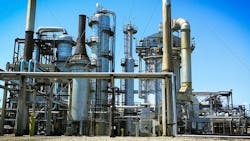Saskatchewan refinery wraps expansion, debottlenecking project
Gibson Energy Inc. has completed an expansion and debottlenecking project at its Moose Jaw, Sask., refinery made possible by Saskatchewan’s Oil and Gas Processing Investment Incentive (OGPII) program, which is aimed to enhance the province’s competitiveness in oil and gas development by enabling increased value-added processing and infrastructure capacity.
Completed on June 29, the expansion will increase the refinery’s throughput capacity by about 30% to 22,000 b/d, with no increase in greenhouse gas (GHG) emissions, ultimately reducing the site’s per-barrel emissions of oil processed by about 20-25%, the government of Saskatchewan said.
Gibson Energy’s Moose Jaw operation consists of a heavy crude oil processing plant that produces a variety of refined products, including distillate and asphalt.
Further details regarding the expansion and debottlenecking project were not revealed.
OGPII program
Gibson Energy is the first successful applicant for the OGPII program, which provides successful applicants with a 15% transferrable royalty credit applied to eligible costs directly related to an eligible greenfield or brownfield project.
Launched in 2017 and designed to support oil and gas producers and companies to grow and generate more value from their operations in the province, the OGPII program can also be used to support improved GHG emissions management projects in the sector, the government said.
To be eligible for OGPII, a project must be a refinery, an upgrading facility, a gas commercialization project, or other value-added facilities, including helium processing, petrochemicals and carbon capture, storage, and utilization for enhanced oil recovery, or a value-added project, the government said.
Eligible projects also must result in a sizeable increase in processing capacity and have a minimum of $10 million (Can.) in eligible costs.
The OGPII program has a royalty credit cap of $75 million/project and a total program credit cap of $300 million in royalty credits.
The OGPII program aligns with the goals of the Saskatchewan government’s Methane Action Plan, which is part of Prairie Resilience: A Made-in-Saskatchewan Climate Change Strategy.
Contact Robert Brelsford at [email protected].
About the Author
Robert Brelsford
Downstream Editor
Robert Brelsford joined Oil & Gas Journal in October 2013 as downstream technology editor after 8 years as a crude oil price and news reporter on spot crude transactions at the US Gulf Coast, West Coast, Canadian, and Latin American markets. He holds a BA (2000) in English from Rice University and an MS (2003) in education and social policy from Northwestern University.

